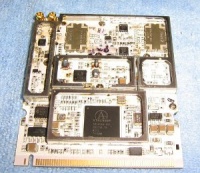430mhz data transfer
Mesh networks using 2.4 or 5 Ghz wifi are becoming popular, and are very practical in densely populated areas. But it would be good to have something more robust for very rural areas.
A way to get around the range limitations of 2.4 Ghz wifi, could be to convert it directly down to a lower frequency, meaning we no longer have the near line-of-sight limitation of typical 802.11. A couple of wireless cards are able to do just this. They the take 2.4GHz system, remove the 2GHz, leaving 400MHz. On the software side it continues to function with the 2.4GHz channel system. There is an amateur band just above 400Mhz - the International Telecommunications Union allocates 430-440MHz for amateurs, and in some countries its wider. However the use of highbandwith data transmission on this band remains a legal grey area.
Singapore based Doodle labs produce the DL435-30 transceiver board and Canadian XAGYL Communications produce the XC420M. Both are mini PCI cards which operate at 420-450MHz and can work with linux wifi drivers. The problem is bandwidth; at microwave frequencies the 10MHz or 20MHz wide channels used by 802.11 wifi is not much, but at 400MHz it is a big chunk of the spectrum and likely to interfere with other things - many common radio controlled devices (for example garage doors) operate on 433MHz. Luckily it is possible to configure 802.11 to squeeze into 5Mhz, of course compromising transmission rate.
- 70cm amateur band english wikipedia article
- Modifying Consumer Off the Shelf Wireless LAN devices for specialized amateur use This article has a section on the 70cm band
The advantage, compared with packet radio or other data transmission techniques is that the hardware/firmware/software for 802.11 systems is already widely used and needs only modifying slightly. The computer 'sees' the 430MHz wireless card as a normal 2.4GHz wifi device, with the usual channels etc.
Contents |
software
The cards 'appear' to be normal 2.4GHz wifi cards, so not many software changes are required. The Ubiquiti Routerstation, comes with OpenWRT Kamikaze. Most of the experiments I have read about use DD-wrt, which has an easy to use web-based interface with a build in option to change the channel with to 10 or 5 MHz (necessary on 430MHz). However, DD-WRT is commercial software, not open source, and the trial version does not allow ssh access to the router. nbd from the OpenWRT project gave quick instructions on how to get the routerstation working with the DL435-30 with a 5MHz channel width, after flashing the firmware from http://downloads.openwrt.org/snapshots/trunk/ar71xx/
opkg update # install the right wireless driver opkg install kmod-ath5k # re-run wifi device detection wifi detect > /etc/config/wireless # edit /etc/config/wireless, enable wifi, set # 'option chanbw 5'
It is also useful to install the LuCI web user interface.
antennas
A simple 1/4 wave antenna is around 14cm long (depending on the channel used). The links below show some other designs.
- 6 Element directional yagi
- DXzone's 70cm antenna links
- 440mhz j-pole design
- Build A 9 dB, 70cm, Collinear Antenna From Coax
amplifiers for 70cm
The UK foundation amateur power limit on this band is 10w. Anywhere other than extremely remote countryside, using these frequencies for this kind data transfer would probably cause interference with other amateurs. Even with 5Mhz channels, this is a considerable chunk of the band. Therefore using amplifiers is perhaps not a great idea. It is also not clear if this equipment would be damaged by such high power signals.
That said, the links below are to build a considerably more powerful amplifier.
- 500w 70cm amplifier kit and assembly guide
- the mosfet datasheet
- rfham.com has prebuilt Module PA 432MHz 500W
other stuff
- WiMAX Demo Shows a 50km Broadband Internet Connection at 450MHz Telsima on cellular news
- 70cm ATV History and case for modified future HSMM use Mostly talks about lisencing issues in the US but has some ideas about data networks on 70cm
- Power over ethernet
- Using the raspberry pi to transmit camera images This project also uses the 430MHz amateur band, but at 300 baud, using the Radiometrix NTX2
- spiderbeam make and sell fibreglass antenna masts up to 26m high
